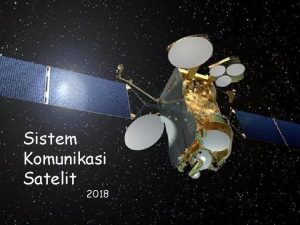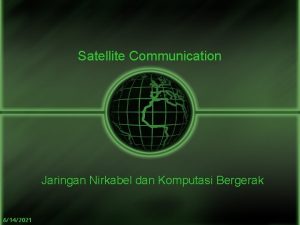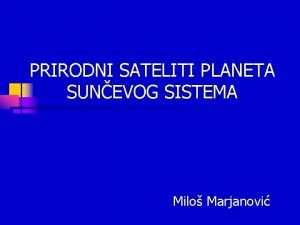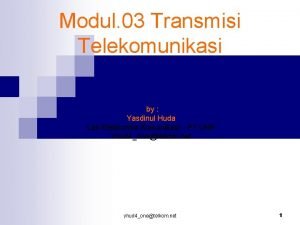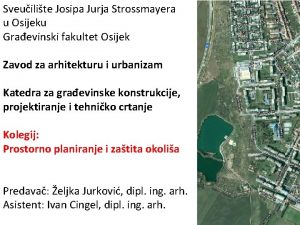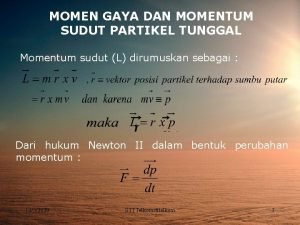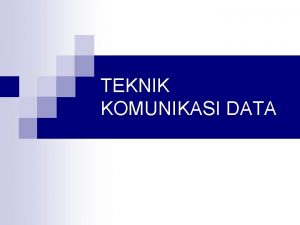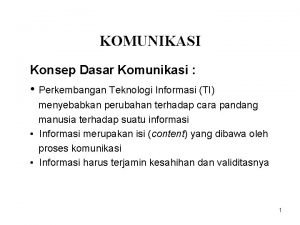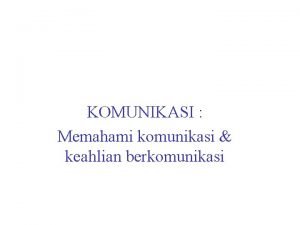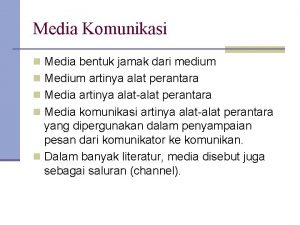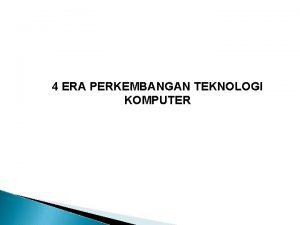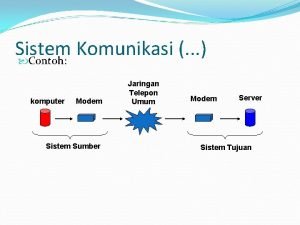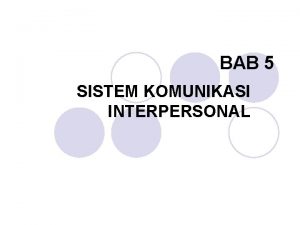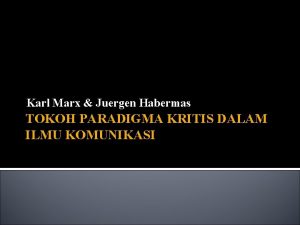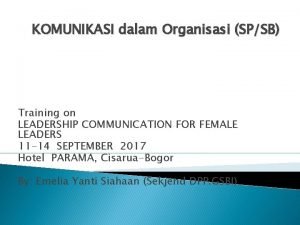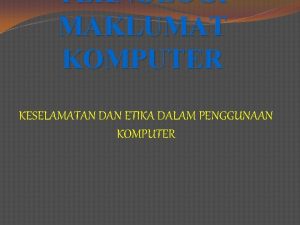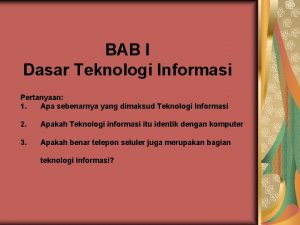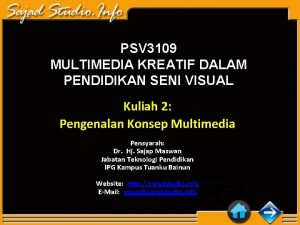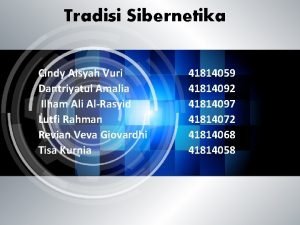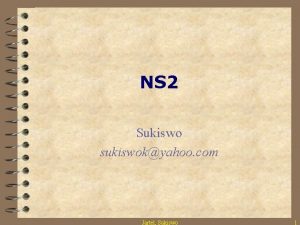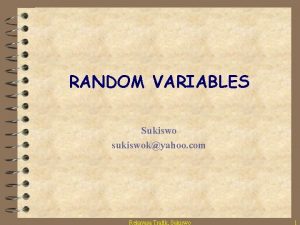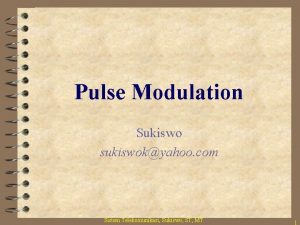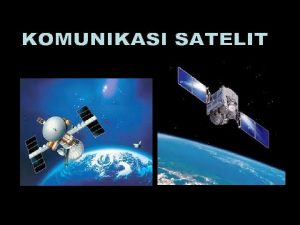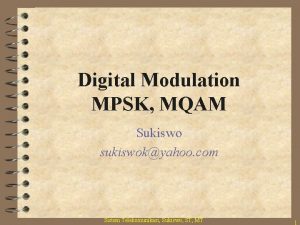KOMUNIKASI SATELIT DIGITAL Sukiswo sukiswokyahoo com Komunikasi Satelit



























































- Slides: 59

KOMUNIKASI SATELIT DIGITAL Sukiswo sukiswok@yahoo. com Komunikasi Satelit, Sukiswo, ST, MT 1

Outline 4 Baseband processing or formatting; 4 Digital modulation and demodulation. 4 Channel coding and decoding; Komunikasi Satelit, Sukiswo, ST, MT 2

Basic communications functions in an earth station. Komunikasi Satelit, Sukiswo, ST, MT 3

Digital Transmission System Komunikasi Satelit, Sukiswo, ST, MT 4

Baseband Formatting • Encryption & Decryption • Scrambling & Descrambling Komunikasi Satelit, Sukiswo, ST, MT 5

Encryption is used when it is wished to prevent unauthorised users exploiting, or tampering with, transmitted messages. It consists of performing an algorithmic operation, in real time, bit-by-bit on the binary stream. Komunikasi Satelit, Sukiswo, ST, MT 6

Encryption The principle of encrypted transmission Komunikasi Satelit, Sukiswo, ST, MT 7

Scrambling 4 In digital transmission, when the bit stream is random, the carrier energy is spread throughout the spectrum of the modulating signal. 4 The principle of energy dispersion is to generate a modulating bit stream which has random properties regardless of the structure of the information bit stream. 4 This operation, which is performed at the transmitter before modulation, is called scrambling. On reception, the inverse operation, performed after demodulation, is called descrambling. Komunikasi Satelit, Sukiswo, ST, MT 8

Scrambling (a) Scrambler (b) Descrambler Komunikasi Satelit, Sukiswo, ST, MT 9

Digital Modulation and Demodulation Komunikasi Satelit, Sukiswo, ST, MT 10

Digital Modulation The principle of a modulator consists of: – a symbol generator; – an encoder or mapper; – a signal (carrier) generator. Komunikasi Satelit, Sukiswo, ST, MT 11

The principle of a modulator Komunikasi Satelit, Sukiswo, ST, MT 12

The principle of a modulator 4 The symbol generator generates symbols with M states, where M = 2 m, from m consecutive bits of the input bit stream. 4 The encoder establishes a correspondence between the M states of these symbols and M possible states of the transmitted carrier. 4 Two types of correspondence can be considered: – direct mapping - one state of the symbol defines one state of the carrier; – encoding of transitions (differential encoding) - one state of the symbol defines a transition between two consecutive states of the carrier. Komunikasi Satelit, Sukiswo, ST, MT 13

The principle of a modulator 4 For a bit rate Rc (bit/s) at the modulator input, the signalling rate Rs at the modulator output (the number of changes of state of the carrier per second) is given by: Rs=Rc/m = Rc/log 2 M (baud) 4 M=2 BPSK 4 M=4 QPSK 4 M=8 8 -PSK dst. Komunikasi Satelit, Sukiswo, ST, MT 14

Two-state phase modulator (BPSK) Komunikasi Satelit, Sukiswo, ST, MT 15

Two-state phase modulator (BPSK) 4 There is no symbol generator since the binary symbol identifies with the input bit. Let bk be the logical value of a bit at the modulator input in the time interval [k. Tc, (k+1)Tc]. 4 The encoder transforms the input bit bk into a modulating bit with logical value mk such that: – for direct mapping (BPSK): mk= bk. – for differential encoding (DE-BPSK): ): mk= bk mk-1, where represents the ‘exclusive OR’ logical operation. Komunikasi Satelit, Sukiswo, ST, MT 16

Two-state phase modulator (BPSK) Relationship between the bit and the carrier phase in BPSK Komunikasi Satelit, Sukiswo, ST, MT 17

Four-state phase modulator (QPSK) Komunikasi Satelit, Sukiswo, ST, MT 18

Four-state phase modulator (QPSK) 4 The symbol generator is a serial–parallel converter which generates two binary streams Ak and Bk, each of bit rate Rc=2, from the input stream of bit rate Rc. 4 The symbol Ak. Bk is a ‘dibit’ which occupies the time interval [k. Ts, (k+1)Ts] equal to Ts=2 Tc or the duration of two bits. 4 The mapper, or encoder, transforms dibit Ak. Bk into dibit Ik. Qk. As discussed above, only direct mapping is typically considered: Ik=Ak Qk =Bk Komunikasi Satelit, Sukiswo, ST, MT 19

Four-state phase modulator (QPSK) 4 The expression for the carrier during the interval [k. Ts, (k+1)Ts] is: 4 Where k=45 o, 135 o, 225 o, or 315 o according to the values of the voltages VI (k. Ts) and Vq (k. Ts). Komunikasi Satelit, Sukiswo, ST, MT 20

Four-state phase modulator (QPSK) QPSK constellation Komunikasi Satelit, Sukiswo, ST, MT 21

Four-state phase modulator (QPSK) 4 Relationship between the bit pair Ak. Bk and the carrier phase in QPSK (direct encoding) Komunikasi Satelit, Sukiswo, ST, MT 22

Variant of QPSK 4 In QPSK modulation, the voltages which modulate the two carriers in quadrature change simultaneously and the carrier can be subjected to a phase change of 180 O. 4 In a satellite link that includes filters, large phase shifts cause amplitude modulation of the carrier. 4 The non-linearity of the channel transforms these amplitude variations into phase variations (see Chapter 9) that degrade the performance of the demodulator. 4 Several variants of QPSK modulation have been proposed to limit the amplitude of the phase shift. Komunikasi Satelit, Sukiswo, ST, MT 23

Variant of QPSK (a) constellation 1, (b) constellation 2, (c) possible phase transitions on successive symbols. Komunikasi Satelit, Sukiswo, ST, MT 24

Variant of QPSK 4 The most popular variants of QPSK are: – offset QPSK (OQPSK); – /4 QPSK; – minimum shift keying (MSK). 4 The INMARSAT aeronautical service uses Aviation QPSK (A-QPSK) Komunikasi Satelit, Sukiswo, ST, MT 25

OQPSK 4 With offset QPSK (OQPSK), also called staggered QPSK (SQPSK), the Ik and Qk modulating bit streams are offset by half a symbol duration, i. e. Ts/2 =Tc, the duration of a bit. 4 The phase of the carrier changes every bit period but only 90 O or 0 O. 4 This avoids the possible 180 phase shift associated with the simultaneous change in the two bits in the modulating dibit with QPSK. 4 It results in a reduced envelope variation when the modulated carrier is filtered. Komunikasi Satelit, Sukiswo, ST, MT 26

/4 QPSK 4 This modulation scheme is another approach to avoiding 180 instantaneous phase shifts. It uses differential encoding. 4 The modulating data Ik and Qk at time k are determined from the incoming dibits Ak. Bk and the previous modulating dibits Ik-1 Qk 1, according to the following transform: where k= /4; 3 /4; - /4, depending on the incoming dibit Ak. Bk (11, 00, 10) Komunikasi Satelit, Sukiswo, ST, MT 27

Minimum shift keying (MSK) 4 This minimum shift keying (MSK) modulation scheme is a special case of OQPSK, replacing the NRZ rectangularshaped pulse voltage associated with bits Ik and Qk by the response to an impulse of amplitude. Vof a pulse filter with impulse response h[t] given as follows : 4 For the Ik stream 4 For the Ok stream Komunikasi Satelit, Sukiswo, ST, MT 28

Higher-order PSK and APSK (a) QPSK (b) 8 -PSK (c) 16 -QAM Komunikasi Satelit, Sukiswo, ST, MT 29

Higher-order PSK and APSK (a) 16 APSK Komunikasi Satelit, Sukiswo, ST, MT (b) 32 APSK 30

Demodulation 4 The role of the demodulator is to identify the phase (or phase shift) of the received carrier and to deduce from it the value of the bits of the transmitted binary stream. Demodulation can be: – Coherent – Differential Komunikasi Satelit, Sukiswo, ST, MT 31

Demodulator for BPSK and DE-BPSK Komunikasi Satelit, Sukiswo, ST, MT 32

Demodulator for QPSK Komunikasi Satelit, Sukiswo, ST, MT 33

Symbol and bit error probabilities 4 Symbol error probability is the probability of a symbol being detected in error; bit error probability is the probability of a bit being detected in error. Komunikasi Satelit, Sukiswo, ST, MT 34

Symbol and bit error probabilities 4 The ratio Ec/No arises in the expression for error probability, where Ec is the energy per channel bit. 4 This is the product of the power of the received carrier for the duration of one bit, namely Ec=CTc = C/Rc. 4 Hence: Komunikasi Satelit, Sukiswo, ST, MT 35

Bit error probabilities (BEP) Komunikasi Satelit, Sukiswo, ST, MT 36

Bit error probabilities (BEP) Komunikasi Satelit, Sukiswo, ST, MT 37

Bit error rate (BER) 4 The bit error rate (BER) measures the performance of the demodulator by counting the number of bits in error, n, in a stream of N received bits BER = n/N 4 The BER constitutes an estimate of the bit error probability (BEP). Alevel of confidence is associated with this estimate, as follows: BEP =BER ± Komunikasi Satelit, Sukiswo, ST, MT 38

Modulation spectral efficiency 4 Modulation spectral efficiency can be defined as the ratio of the transmitted bit rate Rc to the bandwidth occupied by the carrier. 4 The bandwidth occupied by the carrier depends on the spectrum of the modulated carrier and the filtering it undergoes. 4 ISI-free transmissions can be achieved with specific filters displaying smoother transitions in the frequency domain, such as the raised cosine filter. Komunikasi Satelit, Sukiswo, ST, MT 39

Modulation spectral efficiency 4 A larger bandwidth is then required, depending on the value of the roll-off factor . For a raised cosine filter with roll-off factor a, the bandwidth B occupied by the carrier is then: 4 Therefore the spectral efficiency for an M-ary modulation scheme is: where m =log 2 M is the number of bits per symbol. Komunikasi Satelit, Sukiswo, ST, MT 40

Contoh Soal Komunikasi Satelit, Sukiswo, ST, MT 41

Channel Coding and Decoding Komunikasi Satelit, Sukiswo, ST, MT 42

Channel Coding 4 Channel encoding has the objective of adding, to the information bits, redundant bits, which are used at the receiver to detect and correct errors. The principle of channel encoding Komunikasi Satelit, Sukiswo, ST, MT 43

Channel Coding 4 This technique is called forward error correction (FEC). The code rate is defined as: where r is the number of redundant bits added for n information bits. 4 The bit rate at the encoder input is Rb. At the output, it is greater and is equal to Rc. Hence: Komunikasi Satelit, Sukiswo, ST, MT 44

Encoding techniques 4 Two encoding techniques are used: – Block encoding: The encoder associates r bits of redundancy with each block of n information bits; each block is coded independently of the others. The code bits are generated by linear combination of the information bits of the corresponding block. Cyclic codes are most used, particularly the codes of Reed– Solomon (RS) and Bose, Chaudhari and Hocquenghem (BCH) for which every code word is a multiple of a generating polynomial. – Convolutional encoding: (n+r) bits are generated by the encoder from the (N-1) preceding packets of n bits of information; the product N(n+r) defines the constraint length of the code. The encoder consists of shift registers and adders of the ‘exclusive OR’ type. Komunikasi Satelit, Sukiswo, ST, MT 45

Channel decoding 4 With forward error correction (FEC), the decoder uses the redundancy introduced at the encoder in order to detect and correct errors. 4 Various possibilities are available for decoding block and convolutional codes. 4 With block cyclic codes, one of the conventional methods uses the calculation and processing of syndromes resulting from division of the received block by the generating polynomial; this is zero if the transmission is error free. 4 For convolutional codes, the best performance is obtained with the Viterbi decoding algorithm Komunikasi Satelit, Sukiswo, ST, MT 46

Channel decoding 4 Notice that the bit error probability is expressed as a function of Eb/N 0, where Eb represents the energy per information bit; that is, the amount of power accumulated from the carrier over the duration of the considered information bit. 4 As the carrier power is C, and the duration of the information bit is Tb=1/Rb, where Rb is the information bit rate, then Eb is equal to C/Rb Komunikasi Satelit, Sukiswo, ST, MT 47

Channel decoding 4 Eb/N 0 relates to Ec/N 0, where Ec is the energy per coded bit modulating the carrier (bits at output of channel encoder and input to channel decoder) as follows: Komunikasi Satelit, Sukiswo, ST, MT 48

Channel decoding Komunikasi Satelit, Sukiswo, ST, MT 49

Concatenated encoding 4 Block encoding and convolutional encoding can be combined in a ‘concatenated encoding scheme’ Komunikasi Satelit, Sukiswo, ST, MT 50

Concatenated encoding 4 The layout incorporates an outer block encoder, followed by an inner encoder. 4 At the receiving end, the inner decoder corrects errors at the output of the demodulator. 4 The outer decoder is able to correct the occasional bursts of errors generated by the inner decoder’s decoding algorithm, which produces such bursts of errors whenever the number of errors in the incoming bit stream oversteps the correcting capability of the algorithm. Komunikasi Satelit, Sukiswo, ST, MT 51

Interleaving 4 The performance of concatenated encoding is improved while using simple outer coders by implementing interleaving and deinterleaving between the outer and inner coders. 4 Two interleaving techniques are used: – Block interleaving – Convolutional interleaving Komunikasi Satelit, Sukiswo, ST, MT 52

Block Interleaving Block interleaving : bits are organised in blocks of N bits which are sequentially laid down in the B rows of an (N, B) memory array and read out for transmission from the N columns in blocks of B bits. A burst of errors spanning N bits affects only one bit in each transmitted block. This technique introduces a delay approximately equal to 2 NB bits duration. Komunikasi Satelit, Sukiswo, ST, MT 53

Interleaving 4 Convolutional interleaving : bits are organised in blocks of N bits. The ith bit (i =1; 2; . . . ; N) in each block is delayed by (i-1)NJ time units through an (i-1)J stage shift register clocked once every N bit times, where J = B/N. A time unit thus corresponds to the transmission of a block of N bits. 4 The output bits are serialised for transmission. At the receiving end, groups of N bits are reblocked and the ith bit in each block is delayed by (N-i)NJ time units through an (N-i)J stage shift register. 4 This technique introduces a constant delay of (N-1)J time units, equal to N(N-1)J = (N-1)B bit duration. 4 The delay is therefore about half the delay introduced by an (N, B) block interleaver. Komunikasi Satelit, Sukiswo, ST, MT 54

Convolutional Interleaving Komunikasi Satelit, Sukiswo, ST, MT 55

Decoding gain Komunikasi Satelit, Sukiswo, ST, MT 56

Convolutional interleaver-deinterleaver Komunikasi Satelit, Sukiswo, ST, MT 57

Decoding gain The performance of a modulation and coding system; the definition of decoding gain. Komunikasi Satelit, Sukiswo, ST, MT 58

Concatenated encoding 4 Concatenated encoding has been retained for the DVB-S standard. 4 The outer block encoder is an RS (204, 188) encoder where 16 redundancy bytes are added to each input block of 188 bytes yielding output blocks of 204 bytes (code rate =(188/204). 4 The inner encoder is a convolutional code with five different code rates (1/2, 2/3, 3/4, 5/6 and 7/8) 4 The DVB-S 2 standard also makes use of concatenated encoding, but using two block codes: BCH for the outer code and low density parity check (LDPC) for the inner code. Komunikasi Satelit, Sukiswo, ST, MT 59
 Bài thơ mẹ đi làm từ sáng sớm
Bài thơ mẹ đi làm từ sáng sớm Cơm
Cơm Arsitektur komunikasi satelit
Arsitektur komunikasi satelit Earth segment and space segment
Earth segment and space segment Arsitektur komunikasi satelit
Arsitektur komunikasi satelit Arsitektur komunikasi satelit
Arsitektur komunikasi satelit Zemljin naravni satelit
Zemljin naravni satelit Uranov satelit
Uranov satelit Susunan satelit
Susunan satelit Bumi satelit
Bumi satelit Plan grada osijeka satelit
Plan grada osijeka satelit Momentum sudut sistem partikel
Momentum sudut sistem partikel Planet venus terselubung awan putih
Planet venus terselubung awan putih Teknik komunikasi data digital
Teknik komunikasi data digital Etika penggunaan teknologi maklumat dan komunikasi moral
Etika penggunaan teknologi maklumat dan komunikasi moral Data encoding techniques
Data encoding techniques Digital data digital signals
Digital data digital signals Healthtech ecosystem
Healthtech ecosystem Digital data transmission
Digital data transmission Unique features of digital markets
Unique features of digital markets Warga digital
Warga digital E-commerce: digital markets, digital goods
E-commerce: digital markets, digital goods Digital market and digital goods
Digital market and digital goods Oral komunikasi
Oral komunikasi 7 konsep komunikasi organisasi
7 konsep komunikasi organisasi Konsep dasar teknologi informasi dan komunikasi
Konsep dasar teknologi informasi dan komunikasi Pengertian komunikasi
Pengertian komunikasi Intrapersonal adalah
Intrapersonal adalah Sejarah dkv
Sejarah dkv Medium in plural
Medium in plural Jenis kemahiran ict
Jenis kemahiran ict 4 era perkembangan teknologi komunikasi
4 era perkembangan teknologi komunikasi Kelemahan komunikasi interpersonal
Kelemahan komunikasi interpersonal Contoh sistem komunikasi
Contoh sistem komunikasi Apa pengertian komunikasi
Apa pengertian komunikasi Komunikasi kelompok adalah
Komunikasi kelompok adalah Model komunikasi shannon dan weaver
Model komunikasi shannon dan weaver Kata komunikasi diartikan sebagai kata kerja artinya
Kata komunikasi diartikan sebagai kata kerja artinya Contoh latihan asertif
Contoh latihan asertif Keuntungan komunikasi data
Keuntungan komunikasi data Manajemen berasal dari bahasa
Manajemen berasal dari bahasa Medium komunikasi lisan
Medium komunikasi lisan Contoh komunikasi terapeutik pada anak
Contoh komunikasi terapeutik pada anak Surat merupakan sarana untuk
Surat merupakan sarana untuk Pengertian komunikasi efektif
Pengertian komunikasi efektif Sistem interpersonal adalah
Sistem interpersonal adalah Arti ekstempore
Arti ekstempore Paradigma kritis dalam ilmu komunikasi
Paradigma kritis dalam ilmu komunikasi Komunikasi mendatar
Komunikasi mendatar Pendekatan klasik dalam komunikasi organisasi
Pendekatan klasik dalam komunikasi organisasi Isu etika dalam sistem maklumat
Isu etika dalam sistem maklumat Pertanyaan tentang teknologi informasi
Pertanyaan tentang teknologi informasi Pendekatan psikologi komunikasi
Pendekatan psikologi komunikasi Makna indikator
Makna indikator Multimedia seni visual
Multimedia seni visual Tradisi cybernetik
Tradisi cybernetik Teori fusi bakke
Teori fusi bakke Hubungan posisional adalah
Hubungan posisional adalah Simbol dan kode dalam komunikasi
Simbol dan kode dalam komunikasi Prinsip-prinsip komunikasi antarbudaya
Prinsip-prinsip komunikasi antarbudaya



